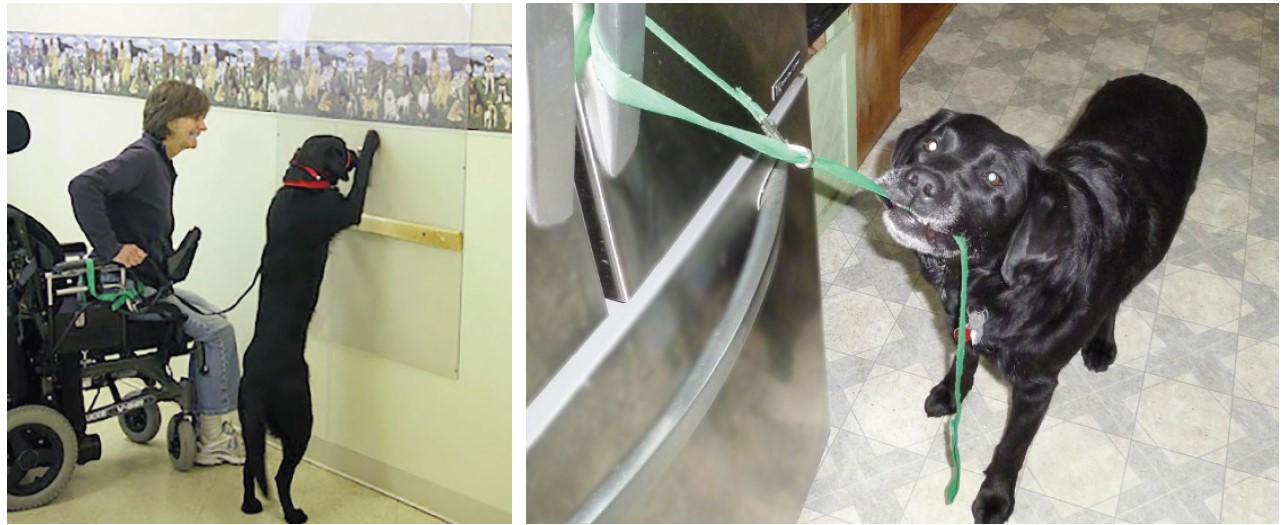
AT YOUR SERVICE: Maggie learned to operate a wall light switch (left), and to open the refrigerator to hand the author her medicine bag (right). "Properly trained dogs are polite, quiet, excited to help you, and love their assignments."
Step 3: Training Your Service Dog. Most of your time will be spent here. Putting in enough time to train your future service dog is a crucial step. While the United States has no minimum requirement, International standards suggest approximately 120 hours over six months. It is recommended that at least 30 of those hours should be time spent in public to help train the dog in moments of distractions and any surprises that may come their way. The most important task for you to teach your service dog is tasking or learning the specific skill they will be performing to help assist with your disability. Some tasks may include sensing a medical alert, tactile stimulation during a panic attack, or grounding/blocking in public areas.
Step 4: The Public Access Test. Once you feel your service dog is trained, it's time to put them to the test! Below is a quick list of the most important criteria for your service dog to pass:
- No aggressive behavior
- Cease sniffing behaviors unless released to do so
- No solicitations for food or affection
- Over-excitement and hyperactivity in public
The Public Access Test is provided by the ADI via PDF form for your convenience.
Step 5: Certification and Equipping. In the United States, service dog certification and service dog identification is not a requirement. Unfortunately, many public employees and places will still require it. For your own convenience, it's good practice to offer to present documents that can help show that your dog is a trained service dog. This will help prevent situations where you are met with hostility when traveling with your service dog. Electing to carry a custom service Dog ID card and Service Dog Vest might be a simpler solution for you and your service dog. You may also choose not to carry the ID card and stand your ground on principle when you encounter people ignorant of service dog rights. After you verbally confirm that your dog is a trained service dog or documentation is shown, reasonable accommodations must be legally made for service dogs. Service dogs provide help for those facing a physical or mental disability so they are granted access to public places such as hotels, restaurants, and malls. It's important to understand these steps to help you or those around you.
WHAT CAN BE ASKED:
Is the dog a Service Animal required because of a disability? What work or task has the dog been trained to perform?
WHAT CANNOT BE ASKED:
Documentation cannot be requested. The dog does not have to demonstrate its tasks. If the disability is obvious, the person cannot be asked what his/her disability is.
I hope this information gives you some good insight into not only the work that goes behind training a service dog, but also the benefits and rewards with successful work. Remember, when you see a service dog and it's barking without a reason to assist its match, then it is most likely not a true service dog. Properly trained dogs are polite, quiet, excited to help you, and love their assignments. •
ABOUT THE AUTHOR:

Ellen Lenox Smith has emerged as a leading voice for patients living with pain in Rhode Island and the country. She suffers from two rare conditions, Ehlers-Danlos Syndrome and sarcoidosis. She enjoyed a career, predominantly in the field of education, before having to resign due to health. She devotes much of her time to advocacy. Presently, she is a co-director for Cannabis Advocacy for the US Pain Foundation, along with being on their board, runs Rhode Island Patient Advocacy Coalition, and was appointed by the governor to both the Adaptive Telephone Equipment Loan Program and the RI Medical Cannabis Oversight Committee representing patients, and helps run the RI EDS Support group. A proud mother of four sons and five grandchildren, Ellen is also an organic gardener, and prior to her disability, was a master swimmer and high school swim coach. She was a staff writer for National Pain Report and 1000 WATTS Magazine before they shut down, was a former staff writer for Pain News Network, and with her husband speaks out to educate others about her condition and pain management. She has spoken to: the FDA, Brown Medical students, Blue Cross nurses, and physical therapy students in RI and CT, along with speaking at the EDS national conferences. She is also the author of two books: It Hurts Like Hell!: I Live With Pain -- And Have A Good Life Anyway and My Life as a Service Dog!